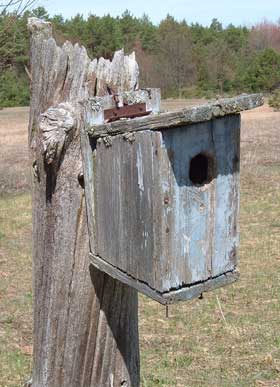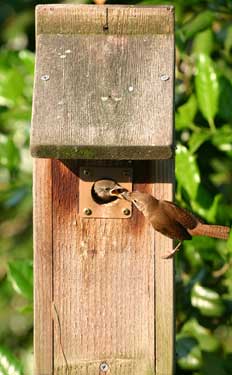 by Jennifer Jones
by Jennifer Jones
When it comes to birdhouses, the size and design depends on the type of bird that will seek out the shelter. Each kind of bird species chooses their nest and homes differently. Some prefer holes near the ground, while others enjoy being up high in the open. Some birds, like cardinals and orioles, do not nest in boxes. A first good step for deciding on birdhouses is to determine which bird species reside in your area and the ones you want to attract.

Bluebirds – Open areas, like orchards, parks, fields and cemeteries; provide a prime attraction space for a pair of bluebirds. They like a box with a small hole, around and inch and a half, that is three to five feet above the ground.
Sparrows – Many people consider sparrows a pest, since they are the most common songbirds in the United States. They often will occupy any possible birdhouse in just about any location from the city to the country. Leafy spaces with ample trees and shrubs are their favorite resting spots. Specific sparrow birdhouses are similar to bluebird boxes and should be placed five to fifteen feet above the ground. However, unlike the bluebirds, sparrows do not like the perches at front of the entrance.
 Wrens – This species is not very picky about the location of their house, since they are very social creatures. They do prefer a one to two inch horizontal slot entrance that will also help deter sparrows from claiming the box. Hang a few boxes at eye-level in partial sunlight.
Wrens – This species is not very picky about the location of their house, since they are very social creatures. They do prefer a one to two inch horizontal slot entrance that will also help deter sparrows from claiming the box. Hang a few boxes at eye-level in partial sunlight.
Finches – Finches enjoy a variety of home designs, from an open platform to an enclosed house. They are common in towns and cities as well as in forests and deserts. Proper predator guards, like additional wood at the entry and mounting on a metal pole, will provide a safer and attractive atmosphere for the finches. Good ventilation and drainage is also a plus.
Purple Martins – Martins are excellent birds to have around your yard, since they eat mosquitos and other flying insects. To attract this entertaining species, put several houses near a pond’s edge with open area around it and at a height of ten to twenty feet above the ground. They prefer an unobstructed flying space at a radius of 40 feet around their birdhouses. Matins nest in groups and enjoy ample sitting spaces, so be sure to have many bird boxes with a lot of perches available.
American Robins – This fairly large thrush species build a nest at the “V” of a tree at about six feet up or higher. Although they do not prefer a birdhouse, you can entice robins to nest in a nearby tree by offering a mud puddle for them to use to hold their nest together.

see Plan #592-002D-0002
Chickadees, Titmice & Nuthatches – All of these species prefer a wooded area and eat the same food. A box mounted or hung from a tree at eye-level will most likely attract one of these birds. To deter sparrows, the entrance hole should be fairly small, around 1 1/8 inches wide. They really enjoy a dense habitat that is composed of thickets or a group of small trees.
Warblers & Brown Creepers – Slab bark houses appeal to these two types of birds. They like to nest in boxes that are attached to the tree’s trunk and placed near water with plenty of wooded trees around the area.
Swallows – Barn swallows, as well as Phoebes, enjoy an open barn or old shed for their nesting locations. To avoid them choosing the ledge over your front door, offer them a nearby nesting shelf. Tree swallows love birdboxes that are attached to dead trees. Space their homes about seven feet apart on the edge of a field that is near water. Violet-green swallows like large trees near partially open woodlands, like forested mountains.

Doves – More particularly the Mourning Dove, these lovely birds enjoy nests composed of twigs, weeds, pine needles, and grass. They naturally nest at tree branch intersections between seven and twenty-five feet. A platform house with partly open sides is ideal for attracting doves. A safe side of a garage or shed that overlooks open spaces is a great location to attract doves.
Woodpeckers – Also know as Northern Flickers, woodpeckers love boxes filled a layer of sawdust or woodchips. They like their homes fairly high on the tree trunk and placed in direct sunlight.
Flycatchers – Often found nesting in old woodpecker homes, flycatchers enjoy wooded suburbs as well as rural areas with plenty of trees. When they nest in a birdhouse, they need to be about ten feet above the ground in a tree that borders an orchard, stream or field.
Wood Ducks – Wood decks naturally make a nest in a tree cavity. They enjoy wood shavings in a box mounted to a three to five foot high post. A house mounted at least twelve feet up on a tree also attracts wood ducks. Be sure to place their nesting box near a body of water for convenience when their eggs hatch. Since wood ducks are a bit larger than the above list of birds, their box needs to be larger, measuring around two feet tall with a four inch wide opening.
Owls – Most owls occupy abandoned nests and rarely build their own. Long-eared and great horned owls enjoy old hawk and crow nests. Screech, barn and other owls prefer tree holes and bird boxes lined with wood shavings. They often inhabit old wood duck and woodpecker nests at a field’s edge or empty orchard. A box places about fifteen feet up on a tree trunk with a sizable opening would be an appropriate owl habitat.
As you can see, every bird species have different preferences when choosing their nesting home. From dense thickets to high open spaces, the adequate birdhouse is required for attracting the desirable bird. Once you have decided which type of bird that you want to house, you are ready for placing the proper birdhouse and enjoying nature in your own backyard.
House Plans and More has over 17,000 house plans and project plans to choose from in a variety of styles and sizes. We also have great Birdhouse Plans! Start searching for your dream home now.
Here are some related articles:
- Winterizing Top To Bottom
- Universal Design: What It Is And Why It's Important
Save this article to:
back to top